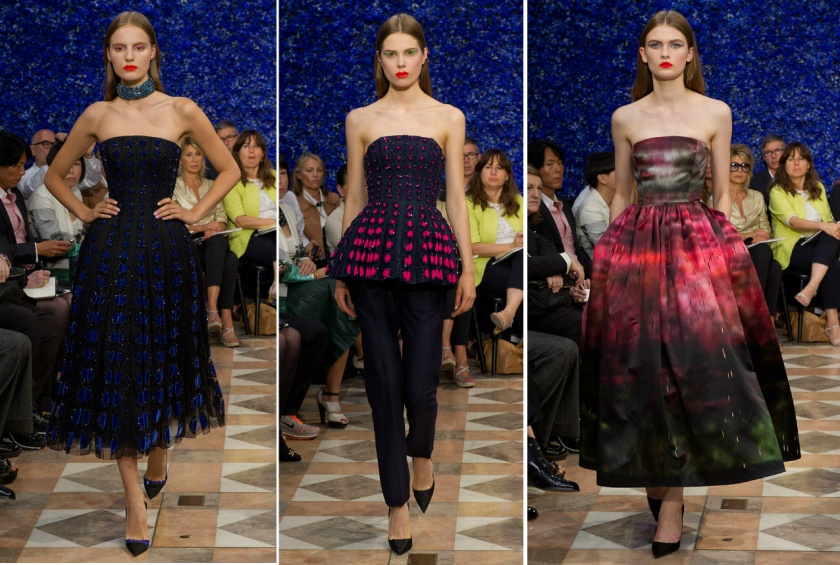The Christian Dior Fall 2012 Couture show was perhaps the most highly anticipated production of the industry; since the infamous John Galliano controversy, the couture house had been at a standstill the last year or so. There as talk of who could possibly take reign. Marc Jacobs? Alber Elbaz? The Rodarte sisters? It wasn’t until April 9 when New York Times writer Cathy Horyn announced Raf Simons to be Galliano’s replacement and successor. And while talent wasn’t a question in this sutation, how Simons would carry on the Dior name and interpret couture was up in the air. Simons himself admitted it to be a challenge.*
After all, we hold onto sepia replays of what haute couture has always been: inexplicably decadent, as if to bring back the bygone days of old world royalty to the 21st century. Always a marvel, but increasingly stuffy as the years went by (I’ve never written about couture for that very reason—I much prefer the wearable versus the impractical or avant garde). The first name that comes to mind upon any mention of the word couture is usually Christian Dior. We remember the wildly extravagant and opulent era of John Galliano—it was Marie Antoinette excessive (a pronoun turned adjective, coined by yours truly). Lavish, extravagant. Frothy. Unabashedly hedonistic. This is what couture had been for the past few decades, and while we suffered financial crisis, decadence was what we clung to. It was an ideal world, a dream state. Call it attachment or tradition—it’s both.
But from this state of waffling Raf Simons emerged successful. He impressed seasoned critics across the board—which, needless to say, is no small feat in this industry. It wasn’t by trying to top Galliano (who could, except perhaps Lacroix?). By reinterpreting Dior’s haute couture, he (maybe) inadvertently reinterpreted modern couture as a whole. With his first collection for Dior he brought couture into the now. This was couture du jour of the 21st century, through today’s eyes.

And it was the perfect start for Dior. A fresh start. Beautiful, simple, modern couture. Flicking through the collection photos was kind of like seeing a black-and-white film: there was a gentle ease about it—nothing too busy—but powerful in impact. Graphic, but in the most graceful way. Black, red, cobalt blue, and galaxy swirls. Katharine Hepburn with the sharpness of Grace Jones, a perfect meeting that gave the entire show an air of subdued drama. Subtle, tasteful drama. There was such incredible balance which was what made the collection so successful: history meets today. Luxe materials juxtaposed with the simplicity of silhouette and clean, minimalist tailoring. Case in point: the fur evening gown. So luxe, and strangely practical. The ingeniousness of a designer lies right there in the ability to merge ideals of luxury into wearability. One is not sacrificed for the other. Fashion’s role is to support a lifestyle, not dictate it.
There’s a bit of a WWII vibe—the androgyny, the treated wool, mid-calf A-line skirts, pumps—that made this minimalist approach easier. It was so forties, a clear tribute referencing Dior’s 1947 start. Touches of art deco influence in the details added optimism via color accents, the bold coral-red lip and mosaic blue backdrop. The collection and showcase together left quite the mark: it was simple and artful. Feminine, but in the most demure, ladylike manner—just not in the traditional sense. Classic A-line shapes for day, a sharp le smoking for night. Almost retro, but made relevant with said graphic changes and hints of porcelain skin. A broad decolletage, an ankle with a cropped pant or ball gown.

And so, Simons pays tribute to Dior and the modern-day woman all in one show. It’s a nod to this evolution of lifestyle and of the woman. The puffy and stuffy ball gowns of couture shows past are finally phased out. In their place is Simons’ streamlined, futuristic version: super clean, super sleek, and cropped. His rendition of the iconic—iconic in both fashion and women’s history—corset is my favorite. Simons’ corset is, again, sleek in shape but well-adorned with embroidery. Let’s call it Corset 2.0. Corset 2.0 is fashioned not under or part of a ball gown, but made into a top. A top paired so wel with a cropped cigarette pant.
What modern-day woman wouldn’t wear that? Its a refreshing take on the typical dress (read: LBD) for an evening out. If I’m not mistaken—my eyes/computer screen could be fooling me—those ankle-length pants are wool. The ensemble is genius for a winter night, instead of shivering in a pair of Wolford tights.

Did Raf Simons singlehandedly change the direction of Dior and alter the course of couture? It’s possible. A part of me, however, feels his timing was right. Success is largely internal, but relies on the external as well. Here we are, for the first time in years, emerging from this economic recession. We’re trying to turn a new leaf—this is a generation of independent women, fiscally speaking and otherwise, who are savvy and privy to finance, marketing ploys, and politics.
We want feminine and feminist, pretty and practical. We want different.
Different is not necessarily new, though. Fashion is a figure-eight of infinity that loops back every so often. It’s fairly predictable, like the economy. We’re back to the 30s and 40s, Rosie Rivetors trying to fight for what they had a fleeting grasp of: respect and independence. Overalls and kerchiefs no longer made the cut, and going back to binding dresses was certainly not an option. To the tweed and jersey separates of Coco Chanel they turned…
Simons is no different. Here’s to a couture revolution.
. . .
x

[…] fall couture 2012: raf simons for christian dior (abitcoquettish.wordpress.com) Share this:TwitterFacebookPinterestEmailLinkedInTumblrLike this:LikeBe the first to like this. Posted in Art, Fashion | Tagged accessories, Art, Beauty, Christian Dior, Christian Dior S.A., Clothing, Consumer Goods and Services, Dior, dress, dresses, Fashion, Footwear, glamour, Haute couture, Paris, Raf Simon, shoes, Shopping, style […]